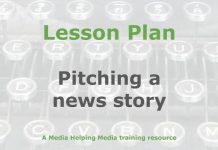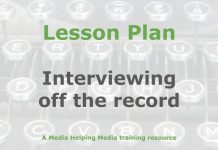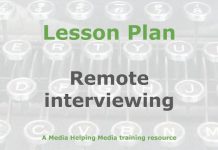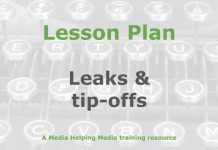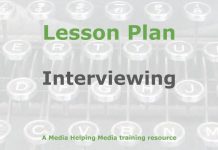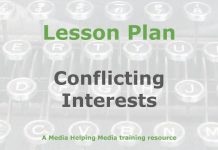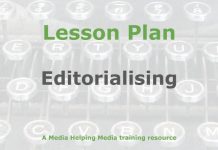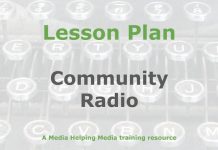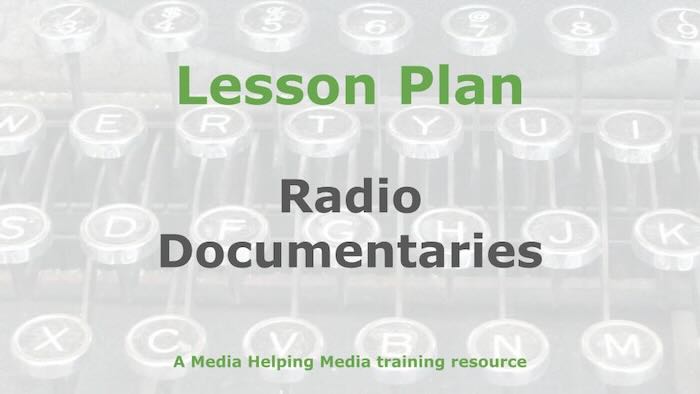 This lesson plan sets out the steps required to make informative long-form news and current affairs documentaries for radio.
This lesson plan sets out the steps required to make informative long-form news and current affairs documentaries for radio.
It’s based on the training module ‘Making documentaries for radio‘ which is published on Media Helping Media and which we recommend you read before adapting the training outline below for your own needs.
Learning objective
Students will construct a compelling long-form radio documentary by integrating research, interviews, and sound elements. They will evaluate the effectiveness of their documentary in engaging listeners and conveying a clear narrative.
- Student-facing objective: By the end of this lesson the student will be able to create an engaging radio documentary using research, interviews, and sound to tell a compelling story.
- Standards: Students will learn how to create long-form radio news and current affairs documentaries.
Learning activities
Warm-up
- Show students a short audio clip from a well-known radio documentary. Ask them to listen carefully then jot down what they notice about the storytelling elements, such as the use of interviews, sound effects, and music.
- After listening, prompt students with: “What storytelling techniques did you notice? How did these elements engage you as a listener?”
- Facilitate a brief discussion, encouraging students to share their observations and thoughts. This will activate their prior knowledge of storytelling and prepare them for creating their own radio documentaries.
Direct instruction
Conceptual understanding: Begin with a brief lecture on the key elements of a radio documentary. Highlight the importance of a compelling story, sound research, and the integration of interviews, sound effects, and music. Use real-world examples to illustrate how these elements work together to engage listeners and convey a narrative. Discuss the balance between script, interviews, and sound effects, emphasising the one-third split guideline.
Procedural skills and fluency: Demonstrate the process of organising and selecting content for a documentary. Use a sample topic and show how to separate recordings into folders for interviews, natural sound effects, and music. Guide students through listening to interviews, selecting strong clips, and arranging them in a logical order. Explain how to write a script that ties these elements together, ensuring every line is evidence-based and factual.
Application: Conduct a live demonstration of assembling a short documentary segment. Use the selected clips, script, and sound elements from the previous step. Show how to integrate natural sound and music to create mood and atmosphere. Read the script aloud in sync with the audio elements, demonstrating pacing and flow. Encourage students to consider how these techniques can be applied to their own projects.
Guided practice
Think, Pair, Share: Guide students through a collaborative exercise to reinforce their understanding of documentary elements.
- Think: Ask students to individually brainstorm a potential topic for a radio documentary. Encourage them to consider the elements of a compelling story, such as connected strands and a central thesis.
- Pair: Have students pair up to discuss their ideas. Instruct them to provide feedback on each other’s topics, focusing on the potential for engaging storytelling and research opportunities.
- Share: Invite pairs to share their refined ideas with the class. Facilitate a discussion on how each topic could be developed into a full documentary, emphasising the integration of interviews, sound effects, and music.
- Select: Ask students to choose one topic from the class discussion that they find most compelling. Encourage them to think about how they would structure the documentary and what elements they would include.
- Plan: Have students outline a brief plan for their chosen topic, detailing the main components such as potential interviewees, sound elements, and the narrative arc. Provide guidance and feedback as needed.
Independent practice
- Direct students to work independently on developing a short segment of their radio documentary.
- Instruct them to select a topic from their plan and gather relevant research and interview clips.
- Have students organise their materials into folders for interviews, natural sound effects, and music.
- Ask them to write a script that integrates these elements, ensuring each line is evidence-based.
- Encourage students to experiment with pacing and flow by reading their script aloud in sync with their audio elements.
Assignment
Ask students to answer these questions:
- What is one key element of a compelling radio documentary?
- How does integrating sound effects and music enhance a documentary?
- What’s one question you still have from today’s lesson?
Here are some suggested answers:
- Suggested answer to Question 1: A compelling story with connected strands and a central thesis.
- Suggested answer to Question 2: Sound effects and music create mood and atmosphere, engaging listeners.
Teacher resources
Differentiation guide
- Advanced learners: Encourage them to explore complex topics with multiple perspectives. Suggest they incorporate advanced sound editing techniques or experiment with narrative structures. Challenge them to create a series or podcast episode, focusing on thematic depth and listener engagement.
- Striving learners: Provide additional scaffolding by breaking down tasks into smaller, manageable steps. Offer templates for scriptwriting and organising content. Pair them with peers for collaborative work, ensuring they receive constructive feedback. Use guided questions to help them identify the main elements of their story.
- Background reading: We recommend you read the training module ‘Making documentaries for radio‘ before adapting this training outline for your own needs.
Notable definitions
Documentary: A long-form audio story that explores a topic in depth, using interviews, sound effects, and music to engage listeners and convey a narrative.
Sound effects: Audio elements used to create mood and atmosphere, enhancing the storytelling by immersing listeners in the scene.
Narrative arc: The structured progression of a story, including the introduction, development, climax, and resolution, which guides the listener through the documentary.
Required materials
- Audio recording equipment (e.g., microphones, recorders)
- Computers with audio editing software
- Headphones
- Access to a library of sound effects and music
- Notebooks and pens for note-taking
- Sample radio documentary clips for analysis
- Folders for organising audio files (digital or physical)
Lesson summary
- Warm-up
- Direct instruction
- Guided practice
- Independent practice
- Assignment
The free teaching tools at the Khan Academy were used as a basis for converting the original article into a lesson plan.
Related article
